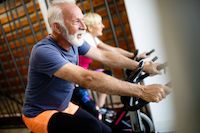Exercise, Physical Activity Reduces Risk of Age-Related Cataracts
Increased physical activity could reduce the risk of developing age-related cataracts by up to 10%.

Results of recent meta-analysis suggest increased levels of physical activity and exercise could help prevent the incidence of age-related cataracts.
Using data from half a dozen studies, a team of investigators found increased physical activity was associated with a 10% decrease in risk of developing age-related cataracts later in life.
“We know that exercise increases antioxidant enzyme activity which has all sorts of benefits, including limiting infections and inflammation in the eye,” said lead investigator Ming Li, PhD, a senior research fellow in the Cancer Epidemiology and Population Health Research Group at the University of South Australia, in a statement. “Age-related cataracts are one of the most common causes of vision impairment and blindness in the world and although surgery is an effective option to recover vision, it is very costly.”
To further evaluate and summarize the impact of physical activity on the prevalence of age-related cataracts, Li and an international team of investigators from Xi'an Jiaotong University and the University of South Australia designed the current study as a meta-analysis of data from the PubMed, Embase, Web of Science, and Cochrane Library databases. Examining the databases from inception through July 2019, investigators identified 6 studies including more than 170,000 participants for inclusion in their analysis. 


To be included, studies needed to be original articles, prospective cohort studies, have physical activity as the exposure of interest, and have a primary outcome of incidence of age-related cataracts. Studies were also required to report relative risks (RRs), odds ratios, or hazards ratios with 95% confidence intervals (CIs) or report sufficient data to calculate them for each outcome. Of note, outcomes could include total cataract, subtype cataracts, or cataract extraction.
From the 6 studies and 171,620 participants, a total of 19,173 cases of age-related cataracts were identified. In regard to characteristics, 4 studies were performed in the US while 2 were performed in Europe. Of the 6, 4 included population-based cohort and 2 examined groups of volunteers. All studies adjusted for age, but not all adjusted for gender, education, smoking, and alcohol consumption.
Upon analysis, investigators found increased physical activity was significantly associated with a reduced risk of developing age-related cataracts. Results of a stratified analysis suggested studies using metabolic equivalent (MET) per day were more likely to report a greater reduction in age-related cataracts (RR, 0.85; 95%CI: 0.81, 0.90, P <.001) than studies assessing activity on a weekly basis (RR, 0.96; 95%CI, 0.89-1.03; P=.24). Additionally, a dose-response analysis found risk of age-related cataracts decreased by 2% for each 6 METs increase in activity per day (RR, 0.98; 95% CI, 0.98-0.99; P <.001).
With age-related cataracts one of the most common causes of blindness, Li noted her hope the results of the current analysis might help provide a greater reason for further engagement in exercise and other forms of physical activity.
“Considering the fact that 24 percent of adults are inactive, these findings will hopefully encourage older people to start exercising on a regular basis,” Li added, in the aforementioned statement.
This study, “Physical activity and risk of age-related cataract,” was published in the International Journal of Ophthalmology.
2 Commerce Drive
Cranbury, NJ 08512
All rights reserved.